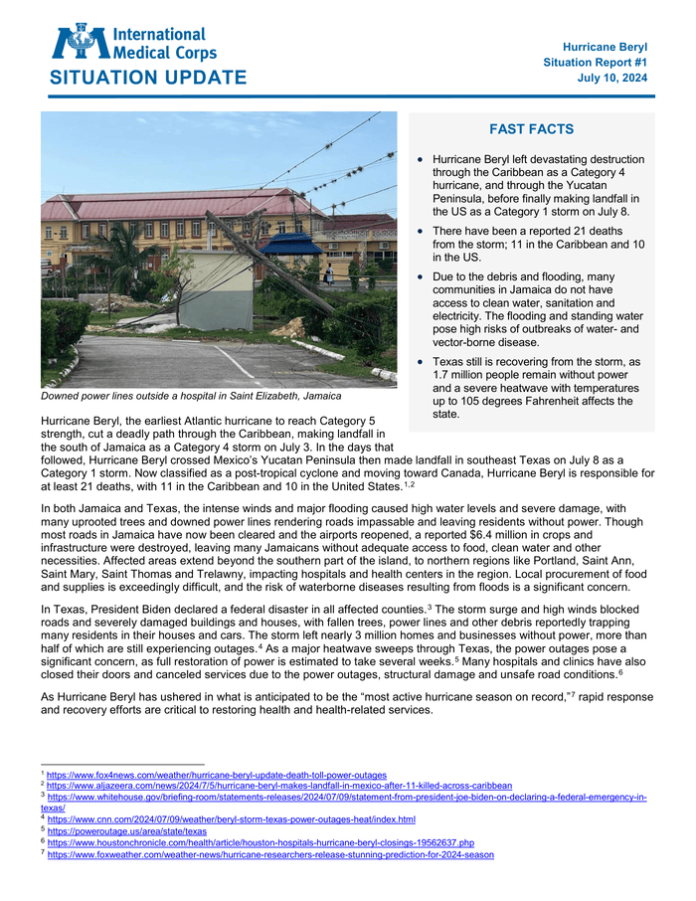FAST FACTS
-
Hurricane Beryl left devastating destruction through the Caribbean as a Category 4 hurricane, and through the Yucatan Peninsula, before finally making landfall in the US as a Category 1 storm on July 8.
-
There have been a reported 21 deaths from the storm; 11 in the Caribbean and 10 in the US.
-
Due to the debris and flooding, many communities in Jamaica do not have access to clean water, sanitation and electricity. The flooding and standing water pose high risks of outbreaks of water- and vector-borne disease.
-
Texas still is recovering from the storm, as 1.7 million people remain without power and a severe heatwave with temperatures up to 105 degrees Fahrenheit affects the state.
Hurricane Beryl, the earliest Atlantic hurricane to reach Category 5 strength, cut a deadly path through the Caribbean, making landfall in the south of Jamaica as a Category 4 storm on July 3. In the days that followed, Hurricane Beryl crossed Mexico’s Yucatan Peninsula then made landfall in southeast Texas on July 8 as a Category 1 storm. Now classified as a post-tropical cyclone and moving toward Canada, Hurricane Beryl is responsible for at least 21 deaths, with 11 in the Caribbean and 10 in the United States.
In both Jamaica and Texas, the intense winds and major flooding caused high water levels and severe damage, with many uprooted trees and downed power lines rendering roads impassable and leaving residents without power. Though most roads in Jamaica have now been cleared and the airports reopened, a reported $6.4 million in crops and infrastructure were destroyed, leaving many Jamaicans without adequate access to food, clean water and other necessities. Affected areas extend beyond the southern part of the island, to northern regions like Portland, Saint Ann, Saint Mary, Saint Thomas and Trelawny, impacting hospitals and health centers in the region. Local procurement of food and supplies is exceedingly difficult, and the risk of waterborne diseases resulting from floods is a significant concern.
In Texas, President Biden declared a federal disaster in all affected counties. The storm surge and high winds blocked roads and severely damaged buildings and houses, with fallen trees, power lines and other debris reportedly trapping many residents in their houses and cars. The storm left nearly 3 million homes and businesses without power, more than half of which are still experiencing outages. As a major heatwave sweeps through Texas, the power outages pose a significant concern, as full restoration of power is estimated to take several weeks. Many hospitals and clinics have also closed their doors and canceled services due to the power outages, structural damage and unsafe road conditions.
As Hurricane Beryl has ushered in what is anticipated to be the “most active hurricane season on record,” rapid response and recovery efforts are critical to restoring health and health-related services.
Summary:
Hurricane Beryl, the earliest Atlantic hurricane to reach Category 5 strength, devastated the Caribbean and parts of the US. Making landfall in Jamaica as a Category 4 storm on July 3 and later in southeast Texas as a Category 1 storm on July 8, it caused extensive damage and resulted in 21 deaths—11 in the Caribbean and 10 in the US. In Jamaica, the storm destroyed $6.4 million worth of crops and infrastructure, leaving many without access to food, clean water, and other necessities. In Texas, nearly 1.7 million people remain without power amid a severe heatwave, with full power restoration expected to take weeks. President Biden has declared a federal disaster in affected counties. The hurricane season is expected to be highly active, making rapid response and recovery efforts crucial.

